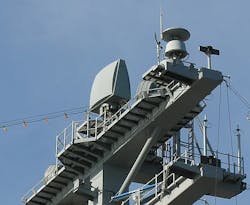Navy asks DRS Laurel to build five more AN/SPQ-9B shipboard missile-defense radar systems
WASHINGTON – U.S. Navy missile-defense experts are asking the DRS Laurel Technologies segment of Leonardo DRS in Johnstown, Pa., to provide AN/SPQ-9B shipboard anti-ship missile defense (ASMD) radar systems to help protect U.S. Navy surface warships from enemy anti-ship missiles.
Officials of the Naval Sea Systems Command in Washington announced a $19.1 million order to DRS Laurel this week to build five AN/SPQ-9B radar systems. The deal also calls for DRS to provide four combat interface kits; first article testing; and a physical configuration audit.
DRS in late April displaced Northrop Grumman Corp. as the Navy's AN/SPQ-9B contractor in a $64.3 million deal for DRS Laurel to build as many as 59 AN/SPQ-9B ASMD radar systems and related equipment. That contract, which combined purchases for the Navy and the government of Japan, included options that could bring its cumulative value to $263 million.
The AN/SPQ-9B is an X-Band pulse-Doppler frequency-agile radar that scans out to the horizon and performs simultaneous and automatic air and surface target detection and tracking of low flying anti-ship cruise missiles, surface threats, low-and-slow-flying aircraft, unmanned aerial vehicles (UAVs), and helicopters.
Related: Raytheon to build new Navy EASR shipboard radar for aircraft carriers and other large ships
The system is connected to shipboard missiles and machine guns for engaging incoming threats.
The radar is designed for the littoral environment in harbors and along coastlines, and has high clutter improvement factor supporting a very low false track rate in the littorals and in high-clutter environments. Its design makes the most of commercial off-the-shelf (COTS) and non-developmental item (NDI) equipment.
The unattended radar consists of four air-cooled below-deck cabinets, a motor generator, and one above-deck antenna unit designed for low-radar-cross-section reflectivity appropriate for stealth ship design.
The AN/SPQ-9B is aircraft carriers, amphibious assault ships, cruisers, Coast Guard maritime security cutters, Arleigh Burke-class destroyers, and allied cruisers and destroyers.
Related: Navy orders 12 advanced AN/SPQ-9B shipboard radar systems from Northrop Grumman
Above decks, the radar uses a mechanically rotating, electronically stabilized antenna. The 1,500-pound antenna consists of dual planar arrays mounted back-to-back, each connected to independent transmitters and receivers.
Below decks, the radar consists of processor, receiver/exciter, and transmitter cabinets; radar set control; and motor generator.
The processor cabinet performs signal processing, tracking, and interface functions. The receiver/exciter has three receivers, and generates system frequencies and clocks. The transmitter cabinet receives the RF pulses from the receiver/exciter and amplifies them for output to the antenna. The radar set control provides remote control and monitoring of radar operation in the ship's combat information center. The output of each receiver is converted to digital baseband I-Q data for Doppler processing in the processor cabinet. The system has an auxiliary antenna for electronic counter-countermeasures.
The AN/SPQ-9B radar has digital interfaces to the Aegis combat systems, the MK 34 gun weapon system (GWS), the MK 48 GWS, the Cooperative Engagement Capability, and ship self defense system.
On this order DRS Laurel will do the work in Johnstown, Pa., and should be finished by January 2025. For more information contact DRS Laurel Technologies online at www.leonardodrs.com/locations/drs-laurel-technologies-johnstown-pa, or Naval Sea Systems Command at paste link here.
Ready to make a purchase? Search the Military & Aerospace Electronics Buyer's Guide for companies, new products, press releases, and videos

